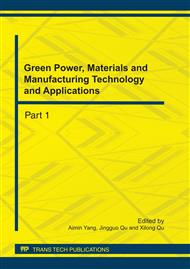[1]
P.S. Ramalhete A.M.R. Senos,C. Aguiar. Digital tools for material selection in product design[J]. Materials and Design, 2010, 31 (5): 2275-2287.
DOI: 10.1016/j.matdes.2009.12.013
Google Scholar
[2]
A. Jahan, M.Y. Ismail, S.M. Sapuan, et al. Material screening and choosing methods—A review[J]. Materials and Design, 2010, 31 (2): 696–705.
DOI: 10.1016/j.matdes.2009.08.013
Google Scholar
[3]
Ineˆs Ribeiro, Paulo Pecas, Arlindo Silva. Life cycle engineering methodology applied to material selection, a fender case study[J]. Journal of Cleaner Production, 2008, 16 (17): 1887-1899.
DOI: 10.1016/j.jclepro.2008.01.002
Google Scholar
[4]
M.F. Ashby. Materials selection in conceptual design[J]. Material Science and Technology, 1989, 5(6): 517–525.
Google Scholar
[5]
M.F. Ashby. Multi-objective optimization in material design and selection[J]. Materials and Design, 2000, (48): 359-369.
DOI: 10.1016/s1359-6454(99)00304-3
Google Scholar
[6]
M. F Ashby, Brechet M, Cebon D, et al. Selection strategies for materials and processes[J]. Materials and Design, 2004, (25): 51–67.
DOI: 10.1016/s0261-3069(03)00159-6
Google Scholar
[7]
S.M. Sapuan. A knowledge-based system for materials selection in mechanical engineering design[J]. Materials and Design, 2001, 22 (8): 687–695.
DOI: 10.1016/s0261-3069(00)00108-4
Google Scholar
[8]
TW Liao. A fuzzy multicriteria decision-making method for material selection[J]. Journal of Manufacturing Systems, 1996, 15 (1): 1–12.
DOI: 10.1016/0278-6125(96)84211-7
Google Scholar
[9]
R. Sarfaraz Khabbaz, B. Dehghan Manshadi, A. Abedian, et al. A simplified fuzzy logic approach for materials selection in mechanical engineering design[J]. Materials and Design, 2009, 30 (3): 687–697.
DOI: 10.1016/j.matdes.2008.05.026
Google Scholar
[10]
A. Shanian, O. Savadogo, A material selection model based on the concept of multiple attribute decision making[J]. Materials and Design, 2006, 27 (4): 329–337.
DOI: 10.1016/j.matdes.2004.10.027
Google Scholar
[11]
R.V. Rao. A material selection model using graph theory and matrix approach[J]. Mater Science and Engineering A, 2006, 431 (1-2): 248–255.
DOI: 10.1016/j.msea.2006.06.006
Google Scholar
[12]
B. D. Manshadi, H. Mahmudi, A. Abedian, et al. A novel method for materials selection in mechanical design: Combination of non-linear normalization and a modified digital logic method[J]. Materials and Design, 2007, 28 (1): 8–15.
DOI: 10.1016/j.matdes.2005.06.023
Google Scholar
[13]
JWK Chan, TKL Tong. Multi-criteria material selections and end-of-life product strategy: grey relational analysis approach[J]. Materials and Design, 2007, 28 (5): 1539–1546.
DOI: 10.1016/j.matdes.2006.02.016
Google Scholar
[14]
K. Maniya, M.G. Bhatt. A selection of material using a novel type decision-making method: Preference selection index method[J]. Materials and Design, 2010, 31 (4): 1785–1789.
DOI: 10.1016/j.matdes.2009.11.020
Google Scholar
[15]
K. Fayazbakhsh, A. Abedian, B. Dehghan Manshadi, et al. Introducing a novel method for materials selection in mechanical design using Z-transformation in statistics for normalization of material properties[J]. Materials and Design, 2009, 30 (10): 4396–4404.
DOI: 10.1016/j.matdes.2009.04.004
Google Scholar
[16]
Guo Wanlin. The Total L ifecycle Des ign of Eng ineer ing Products [J]. China mechanical engineering, 2002, 13 (13): 1153-1158.
Google Scholar


